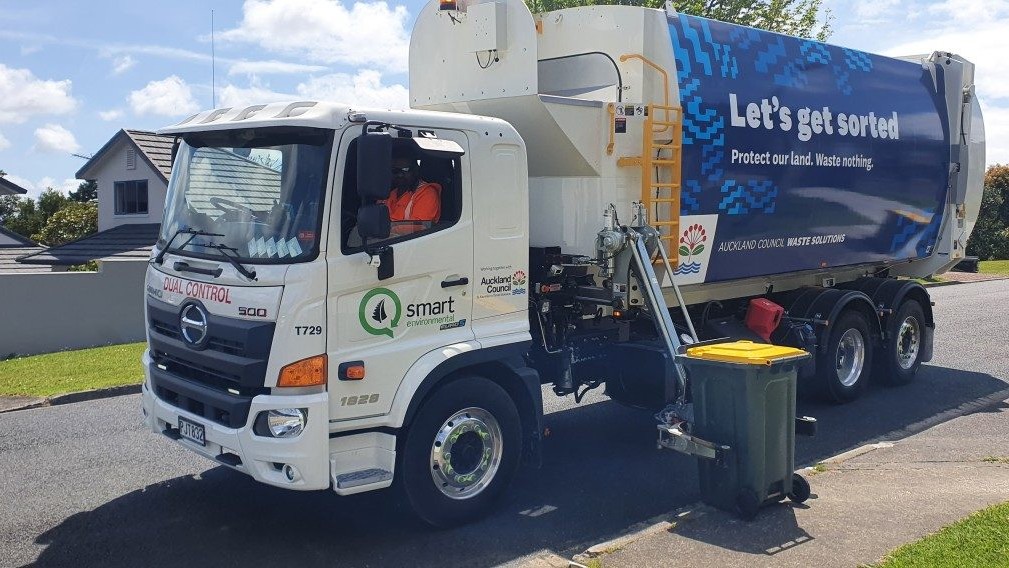Auckland trials uses AI in waste collection trucks

Waste management company Smart Environmental has completed the first Australasian trial of an active safety solution for side-arm heavy vehicles that significantly improves public safety around waste trucks.
MAX-SAFE Side-Arm Pedestrian Protection is a new camera-based AI solution designed to detect and protect pedestrians and other vulnerable road users (VRUs) from the unique operations of side-arm waste management vehicles.
Developed by Australian company, SGESCO-MAX, the solution for the trial was integrated with Bucher Municipal’s side arm Recycling truck mechanics to audibly and visually alert the vehicle driver and pedestrians – and actively halt the vehicle’s side arm or move it to a safer position – thereby preventing collision with a person or object. It was the first time such a system had been used in New Zealand.
According to Smart Environmental’s general manager fleet & systems, Jonathon Dick, the company had identified a heightened and alarming safety risk around kerbside operations of its municipal vehicles due to several factors:
- COVID-19 had seen more people at home and subsequently staying at/around home during waste collection times.
- Technology has made people more distracted with less peripheral awareness (watching or listening to content on smartphones, distracted with conversations, earphones on to quieten exterior noise).
- The rise of e-scooters often on footpaths.
- Recycling trucks were more sophisticated with drivers often relying on in-cabin camera monitoring rather than looking outside.
Dick noted that while there had been no major safety incidents, risk assessments all pointed towards a perfect-storm scenario.
To date, Smart Environmental had addressed this risk with traditional mirrors and cameras. Keeping people safe, however, required drivers identifying a risk and responding in time to manually stop the movement of the hydraulic side arm.
Typical residential wheelie bins are 240L and once full can be of a reasonable weight. If the arm or the bin (empty or full) were to collide with a person, it could cause serious injuries.
“Aside from protecting the public, we wanted to remove the pressure and stress on our drivers facing this more prevalent safety risk – and worse having to deal with a disastrous aftermath,” said Dick. “A better solution was needed.”
The MAX-SAFE Side-Arm Pedestrian Protection solution includes dual cameras mounted on the cabin and body of the vehicle in the optimal position to cover the operation of the Side-Arm.
Using the latest advances in AI and machine ;earning, the solution detects VRUs within a defined work zone along the left side of a vehicle including a few metres to the front and rear. The zone is fully configurable.
With all safety modules included, it will identify when a pedestrian(s) is within the zone where the side-lift arm operates, as well as:
- Warn the operator via an in cabin audible voice alert and flashing light
- Warn the pedestrian(s) via audible voice alert and external flashing LED light bar
- Stop the side-lift arm from operating and, if safe to do so, raise it to its highest position, thereby removing the arm as a safety hazard.
Following months of R&D, including full factory testing, at the start of November 2023, the side arm safety solution was installed on one of Smart Environmental’s Recycling vehicle operating across north Auckland.
As part of the one-month trial, a camera was set-up whereby the driver could instantly tap a button to record what was happening outside the vehicle once an alert went off.
“The integrated MAX-SAFE BUCHER solution prevents the arm from entering the area and removes the arm from the hazard error. It combats the risk of drivers becoming de-sensitised to humans around the vehicle and accidents not happening, when, in reality, they are moments away from happening. It safeguards drivers and the public,” said Dick.
Following the trial, Smart Environmental would begin work with various councils across New Zealand to appraise them of the risks and findings of the trials so they could collectively plan the way forward for safer kerbside collections.





